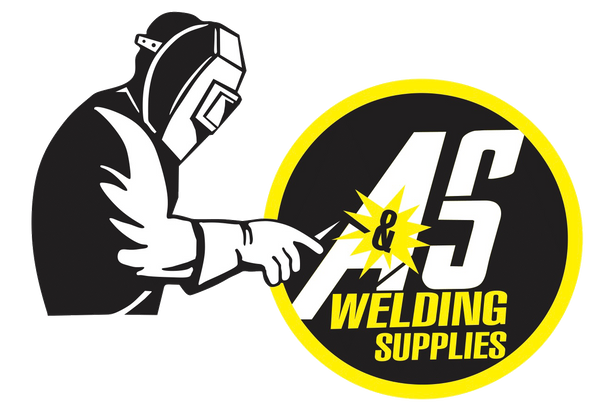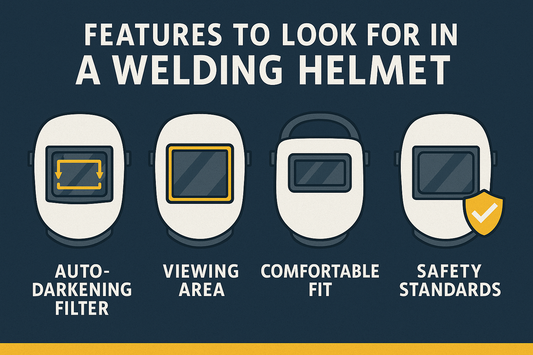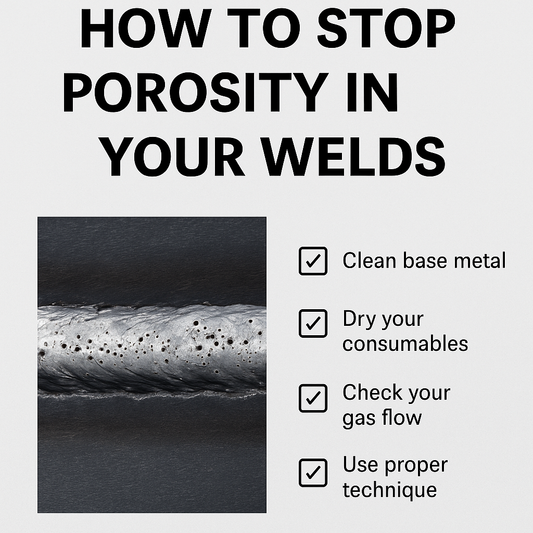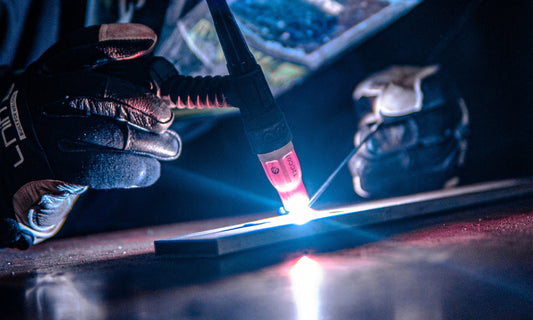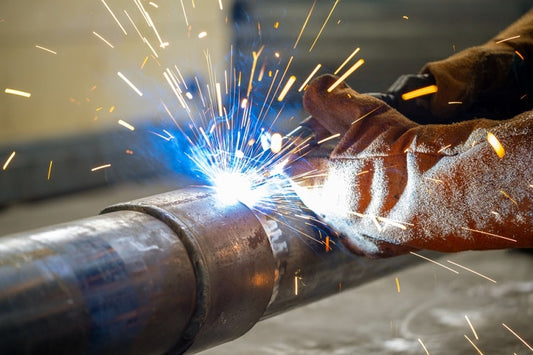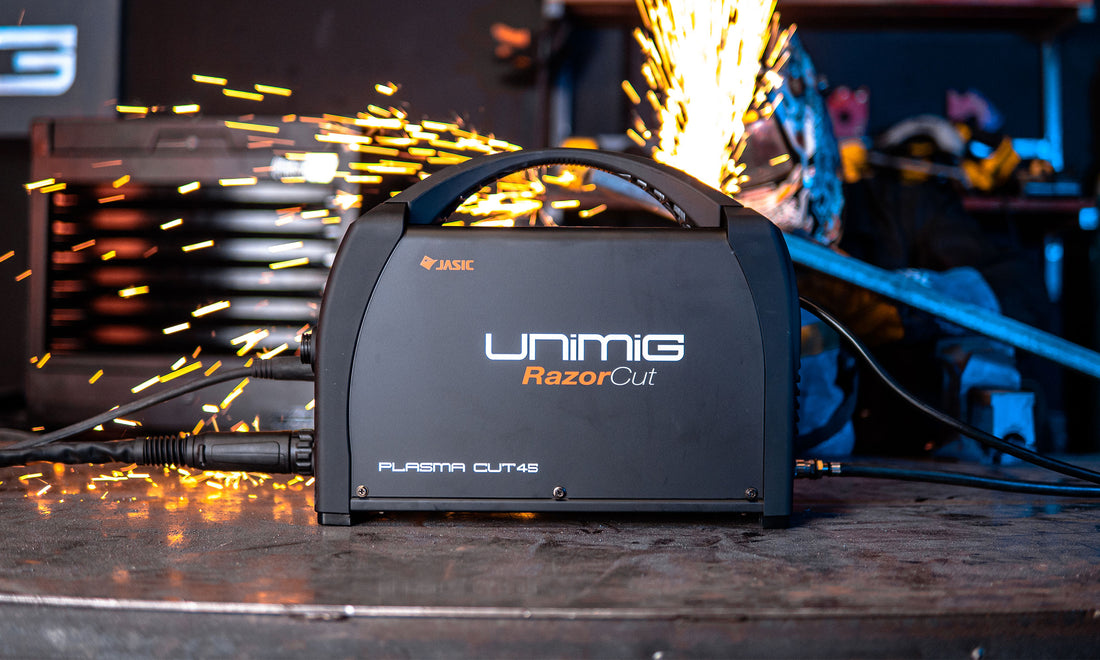
Choosing the Right Plasma Cutter for You
Share
Plasma cutting is a melting process that uses plasma and an outside power source to create an electric arc between the electrode and the metal being cut. The plasma jet melts the metal to make the cut, and the air attached to your machine blows it away. Plasma can cut through anything electrically conductive; steel, stainless steel and aluminium are all fair game.
So, what do you need to get to get started with your plasma cutting?
Air Compressors
Plasma cutters in Australia are made to work on compressed air only, including UNIMIG machines. If you want to plasma cut, you’re going to need an air compressor to connect to your machine.
When purchasing a compressor, make sure to get one that can deliver 70–120psi and has an airflow/intake volume rating that is greater than your plasma cutters.
Your plasma cutter will state the litres per minute (L/min) it uses, so you’ll want a compressor that states a higher number than that. You don’t want to run out of air before you’ve finished your cut.
You can also buy plasma cutters that have a built-in air compressor. There are benefits to both options, so you’ll need to consider before deciding which will work best for you.
| Pros | Cons | |
| External Air Compressor | More Power | Not Portable |
| Built-in Air Compressor | Portable | Less Power |
Clean Cut vs Severance
You can get two types of cuts with your plasma cutter: a clean-cut or a severance cut.
Clean cut: a smooth, clean-cut through the metal.
Severance: a cut all the way through, but it won’t be smooth or pretty, and if you plan on working on it after, you’ll need to clean it up.
Usually, every plasma cutter will have a maximum clean cut thickness and a maximum severance it can do. These indicate how thick the metal can be if you want a good quality cut and how thick the metal can be if all you need is to get through it. The severance thickness will always be more than the clean-cut thickness. These cut depths will also change depending on the metal type.
Back Arc vs High Frequency
There are two arc ignition types when it comes to plasma cutting, though both are considered ‘pilot arc’.
The first is High Frequency (HF). A HF plasma torch needs to be in very close proximity for the arc to spark and begin the ionising process. The arc jumps from the torch to the metal, and HF torch consumables generally wear out faster because of this.
The second type is Back Arc Strike. A torch will start up automatically with just the touch of a button through a spring-loaded design inside the torch head. The benefit of a back arc start is that it’s a lot more user friendly. It doesn’t matter if your metal is rusty or otherwise not clean; a back arc torch can cut straight through all of it. CNC table plasma cutting torches are also back arc strike ignition.
The back arc strike torches are much more common and popular these days, as HF torches run the risk of disrupting sensitive equipment that might be nearby, such as hospital machinery and computers.
Every UNIMIG plasma cutter comes with a back/pilot arc capable torch.
Plasma Cutters

VIPER CUT 30 Mk II Plasma Cutter
- Comes with an SC30 Plasma Torch
- CNC connection
- Pilot Arc start
- 12mm Clean Cut
- 14mm Severance
- Duty cycle: 15% @ 30A
- Gas flow: 170L/min
- 10 AMP plug
Like our welding machines, UNIMIG also has a VIPER version plasma cutter. It’s lightweight, with a 10 AMP plug, so you won’t have trouble finding a socket, making it perfect for home DIY projects or for taking offsite. It can clean cut through over 10mm of steel, which is pretty thick metal when you think about it. The Viper Cut Mk II machine comes with the SC30 torch and a CNC connection port, so it’s perfect for every use case.

RAZOR CUT 40 AIR Plasma Cutter
- Comes with an SC80 Plasma Torch
- Built-in air compressor
- Pilot Arc start
- 10mm Clean Cut
- 12mm Severance
- Duty cycle: 25% @ 40A
- Gas flow: 120L/min
- 15 AMP plug
The main feature the RAZOR CUT 40 Air has is it comes with a built-in air compressor. It has more portability than any of our other plasma cutters, and you won’t need to go out and buy an air compressor. It still requires a power source, a 15 AMP one at that, because it needs the electricity to run the added component that’s inside and ignite an arc. The built-in compressor means that if you’re planning on doing outdoor work, or any work that’s going to need distance from where you’d place an air compressor, this is the machine for you. It has the option of an external connection, so if you need a thicker cut, you can get a separate air compressor and make thicker cuts.
View more info: RAZOR CUT 40 AIR

RAZOR CUT 45 Plasma Cutter
- Comes with an SC80 Plasma Torch
- CNC connection
- Pilot Arc start
- 16mm Clean Cut
- 20mm Severance
- Duty cycle: 25% @ 45A
- Gas flow: 189L/min
- 15 AMP plug
View more info: RAZOR CUT 45

RAZOR CUT 80 Plasma Cutter
- Comes with an SC80 Plasma Torch
- CNC connection
- Pilot Arc start
- 30mm Clean Cut
- 35mm Severance
- Duty cycle: 40% @ 80A
- Gas flow: 189L/min
View more info: RAZOR CUT 80

RAZOR CUT 120 Plasma Cutter
- Comes with an SC120 Plasma Torch
- CNC connection
- Pilot Arc start
- 45mm Clean Cut
- 60mm Severance
- Duty cycle: 60% @ 120A
- Gas flow: 189L/min
View more info: RAZOR CUT 120
These machines are generally the same, with the exception being their max amps and, therefore, their max cutting thicknesses. These are usually recommended for a workshop or professional environment because of the power they require, but the 45 comes with a 15 AMP plug. This is great because you can easily get one of those for your home, and then you can hook it up to a CNC table. The CNC connection is one of the coolest features on all three of these machines, and it’s available on the 45, 80 and 120.
Plasma Torches
SC30 Plasma Torch
- Stand off cutting
View more info: SC30 Plasma Torch

SC80 Plasma Torch
- Contact cutting
- Stand off cutting
- Gouging
View more info: SC80 Plasma Torch
These torches come with their respective machines, and they vary in terms of the pin setup that plugs into the machine, so you’ll need to keep that in mind if you want to swap to a HF torch. When you’re buying a machine and torch, make sure you get one that has the type of consumables you want, as there are a few types of cutting available. Stand off cutting is the most common, and it gives your consumables the longest life.

SCM80R Plasma Torch
- Duty cycle: 60% @ 80A
- Pilot Arc
The SCM80R is a CNC specific torch. It is designed for use on a CNC plasma table. If you’ve purchased a plasma cutter that can connect to a CNC table, then you’ll likely also need a torch that is compatible as well. Unfortunately, the only thing we don’t sell is the actual CNC table itself. However, if you’ve got one available to you, we’ve got all the parts you’ll need to get it up and running.
View more info: SCM80R Plasma Torch
